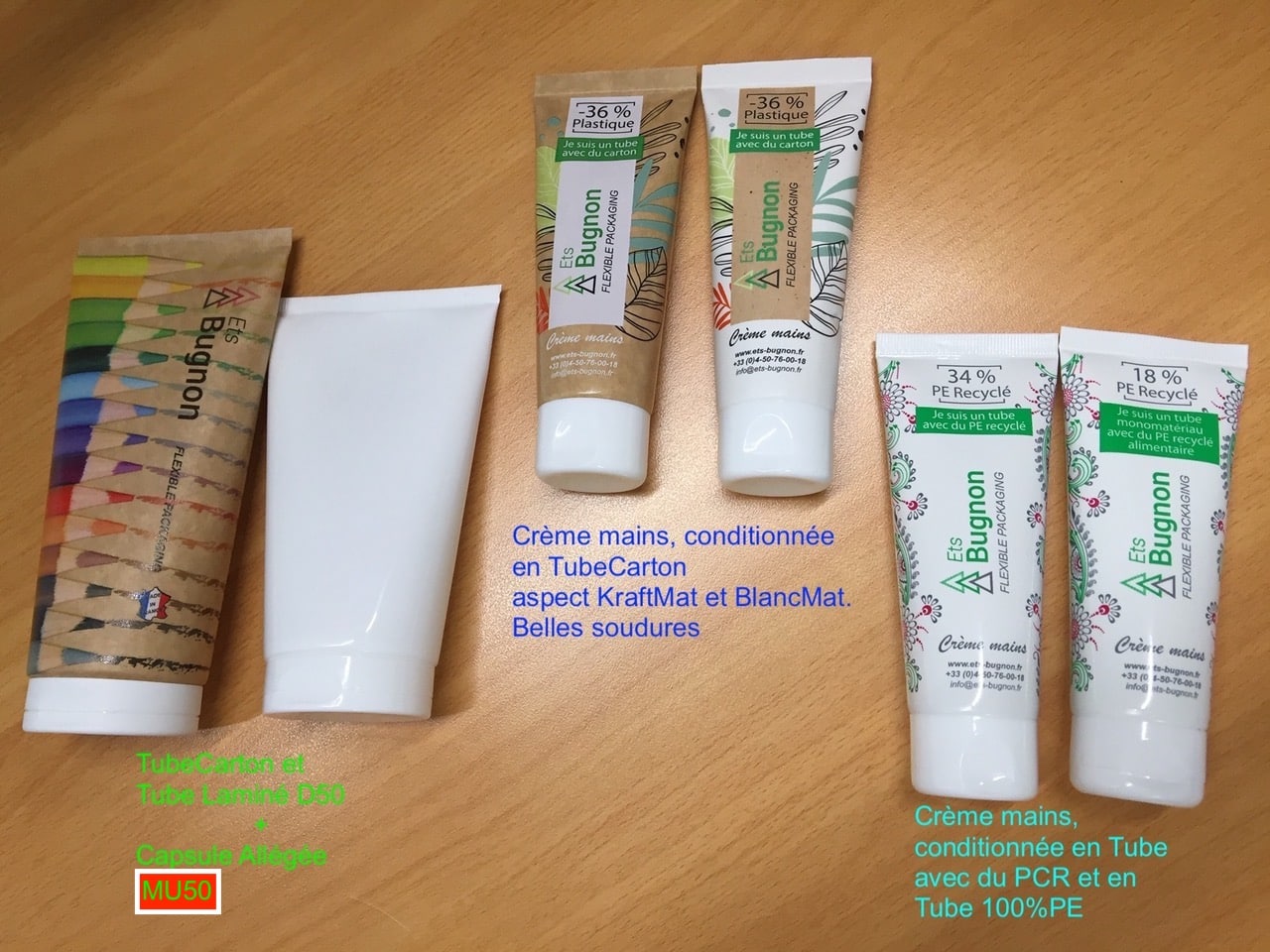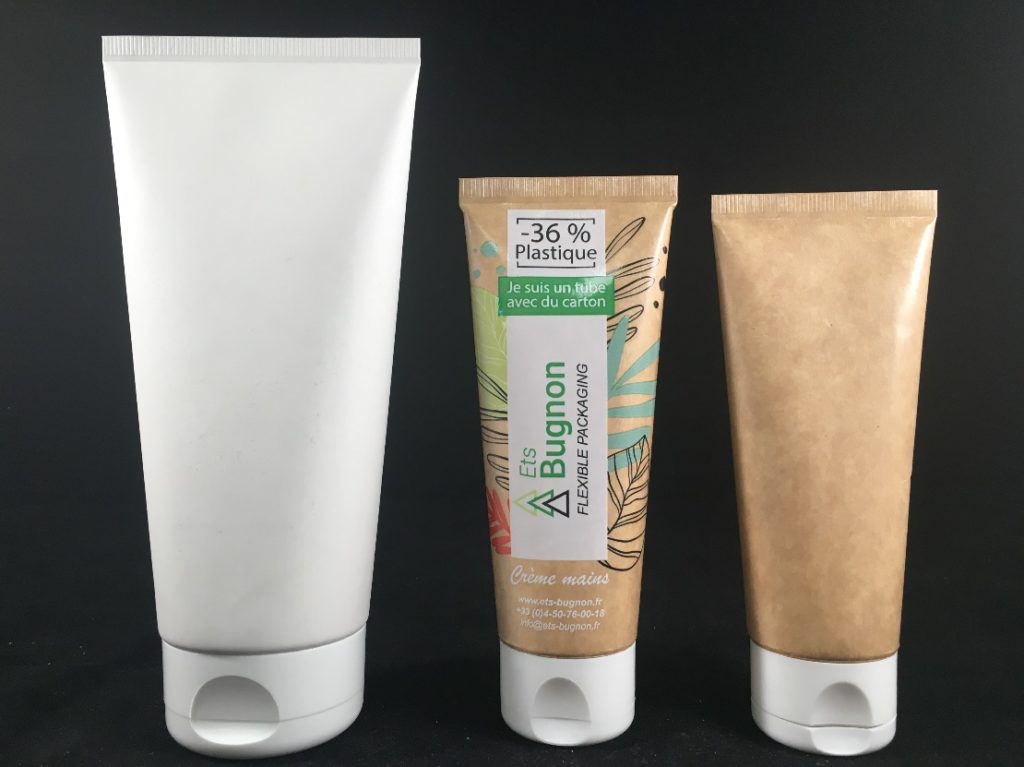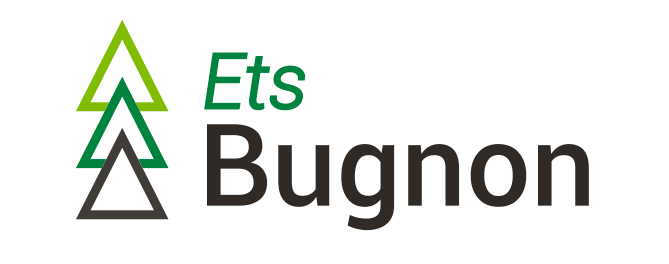Sustainable tube or eco-designed tube
Plastic packaging is subject to increasingly restrictive regulations designed to limit its environmental impact.
The EU Regulation set out the framework and objectives to be achieved:
1- Reduce the weight of plastic packaging
2- Reuse packaging
3- Recycle and integrate recycled materials into plastic packaging
Ets Bugnon offers eco-responsible tubes that meet the Reduce and Recycle objectives, as well as an eco-refill to support the Reuse objective.
Find out more about the EtsBugnon Eco-Refill on the dedicated page.
All our plastic tubes are recyclable.
Find out more about tube recyclability in the French CITEO COTREP study below.
1. OBJECTIVE REDUCE PLASTIC
The light weight tube
What is a light weight tube?
Extruded tubes have a standard thickness of between 450µm and 500µm, averaging 470 µm.
Our extruded tubes are now available with a refined parison of 420 µm, a 10% reduction in the weight of the tube body.
And our laminated tubes are even thinner, with a 300µm HDPE-Evoh-HDPE multilayer film.
Compared with a conventional extruded tube, tube body weight reduction is 38%!
These thin-wall tubes can be combined with our lightened flip top cap, presented below.
5 000
Minimum orders per diameter
The light flip top cap
What is a light flip top cap?
Reducing the weight of our plastic tubes is also possible by choosing our snapped slim line flip top caps.
While retaining the functionality of a standard flip top cap, the lightened cap provides effective visual differentiation, as the consumer immediately perceives the reduction in packaging.
Our lightened flip top cap is made of PE rather than PP like standard caps, for a 100% PE monomaterial extruded tube and a 95% PE and 5% Evoh laminated tube (barrier layer compatible with PE recycling).
Available in ø35/40/50 mm, item codes MU35 – MU40 – MU50.
5'000
in white with standard orifices
25'000
with non-standard orifices
Weight savings with lightweight flip top cap:
| Diameter | Standard flip top cap + shoulder weight | Slim line flip top cap + shoulder weight | Weight reduction |
|---|---|---|---|
| Ø35 mm | 6,75 g | 5,40 g | 20% |
| Ø40 mm | 7,19 g | 5,96 g | 17% |
| Ø50 mm | 10,65 g | 7,91 g | 25% |
Technical information – combination of refined tube and lightened flip top cap:
Example of weight savings on a 250ml D50x180 mm HDPE standard thickness reference tube and standard clip-on flip top cap:
| Characteristics Tube 250ml D50x180 | Total tube weight | Plastic reduction |
|---|---|---|
|
Extruded HDPE tube, standard thickness 470µ
With standard clip-on flip top cap |
24,04 g | / |
|
Extruded HDPE tube, refined thickness 420µ
With standard clip-on flip top cap |
22,63 g | 6% |
|
Extruded HDPE tube, refined thickness 420µ
With lightened clip-on flip top cap |
19,89 g | 17% |
|
PEHD-Evoh laminated tube, 300µ refined thickness
With standard clip-on flip top cap |
18,76 g | 22% |
|
PEHD-Evoh laminated tube, 300µ refined thickness
With lightened clip-on flip top cap |
16,02 g | 33% |


Tube with cardboard or paper
What is a cardboard tube?
It’s a tube whose body is made from a complex film comprising cardboard and plastic, in WHITE or KRAFT appearance, with a shoulder and a cap in plastic.
The thickness of this complex film is 333µm.
The structure is as follows (outer layer to inner layer): PE/CARTON/PE-Evoh-PE
The Evoh layer provides a barrier to oxygen and ingredients.
What is a paper tube?
In this case, the tube body is a complex film composed of paper and plastic, available in a white finish.
There is no outer plastic layer, only a triple inner layer: PE-Evoh-PE. Printing is therefore carried out directly on the paper, and varnishing is strongly recommended.
The thickness of the laminated film is 320µm.
The shoulder and closure are identical to the tube with cardboard.
We are working to reduce the plastic content of our cardboard and paper tubes, so that they can be recycled as PPC (paper-cardboard-complex).
The filling and sealing of cardboard and paper tubes can be carried out on a conventional tubing machine, with a few adjustments or adaptations.
Today, these cardboard and paper tubes offer the greatest reduction in plastic weight.
10 000
Minimum orders per diameter
2. OBJECTIVE REUSE
Ets Bugnon helps its customers to reuse their pump bottles and jars, from 100ml to 300ml.
Our EtsBugnon Eco-Recharge refill solution is an original single-dose alternative to existing solutions such as berlingots or Doypack.
Find out more about the EtsBugnon Eco-Refill on the dedicated page.
3. OBJECTIVE RECYCLE & INTEGRATE RECYCLED PLASTIC
All our plastic tubes are recyclable.
For optimum recycling, we recommend the 100% PE single-material extruded tube with the lightened flip top cap.
And we can combine PE lightened flip top cap, fine parison extrusion and PCR recycled plastic for an even more eco-responsible tube!
Tube with recycled plastic
What is a PCR tube?
PCR stands for Post Consumer Recycled.
PE-PCR, or r-HDPE, is a plastic material derived from the recycling of rigid HDPE packaging (from sorted household packaging via sorting bins or closed sorting loops).
We offer PCR with or without food contact: the proportion of integrated PCR varies according to the grade required.
Tubes produced with PCR significantly reduce the use of virgin petro-sourced plastics and contribute to the development of a circular economy.
5'000
Minimum orders per diameter
Technical information tube with PCR :
Example of weight savings of virgin PE on a 250ml D50x180 mm reference tube in standard thickness HDPE and standard clip-on flip top cap:
| Characteristics Tube 250ml D50x180 | PE PCR weight | Total weight of virgin plastic | % of PE PCR | Reduction of virgin plastic |
|---|---|---|---|---|
|
Extruded HDPE tube
Standard thickness 470µ With standard clip-on flip top cap |
/ | 24,04 g | / | / |
|
Single-material extruded tube
With food contact PCR 38% in the body Refined thickness 420µ With lightened clip-on flip top cap |
4,48 g | 15,22 g | 23% | 36% |
|
Single-material extruded tube
Without food contact PCR 73% in the body Refined thickness 420µ With lightened clip-on flip top cap |
8,70 g | 11,13 g | 44% | 54% |
4. ANOTHER ECO-RESPONSIBLE SOLUTION: BIOSOURCING
The tube with plant-based PE
What is a plant-based polyethylene tube?
Conventional polyethylene is produced by refining petroleum, a non-renewable fossil fuel.
Bio-based polyethylene is produced from ethanol derived from sugar cane.
Sugar is fermented and distilled to produce ethanol, which is then dehydrated to create ethylene.
Polymerization of ethylene produces polyethylene.
Plant-based polyethylene has exactly the same processing and recycling characteristics as conventional polyethylene: it is biosourced and recyclable, but not biodegradable.
Its carbon footprint is lower than that of petro-sourced PE, as the sugar cane absorbs CO2 during the cultivation phase.
For more information, click here.
Tubes made with plant-based PE significantly reduce the use of petro-sourced plastics.
5 000
Minimum orders per diameter
